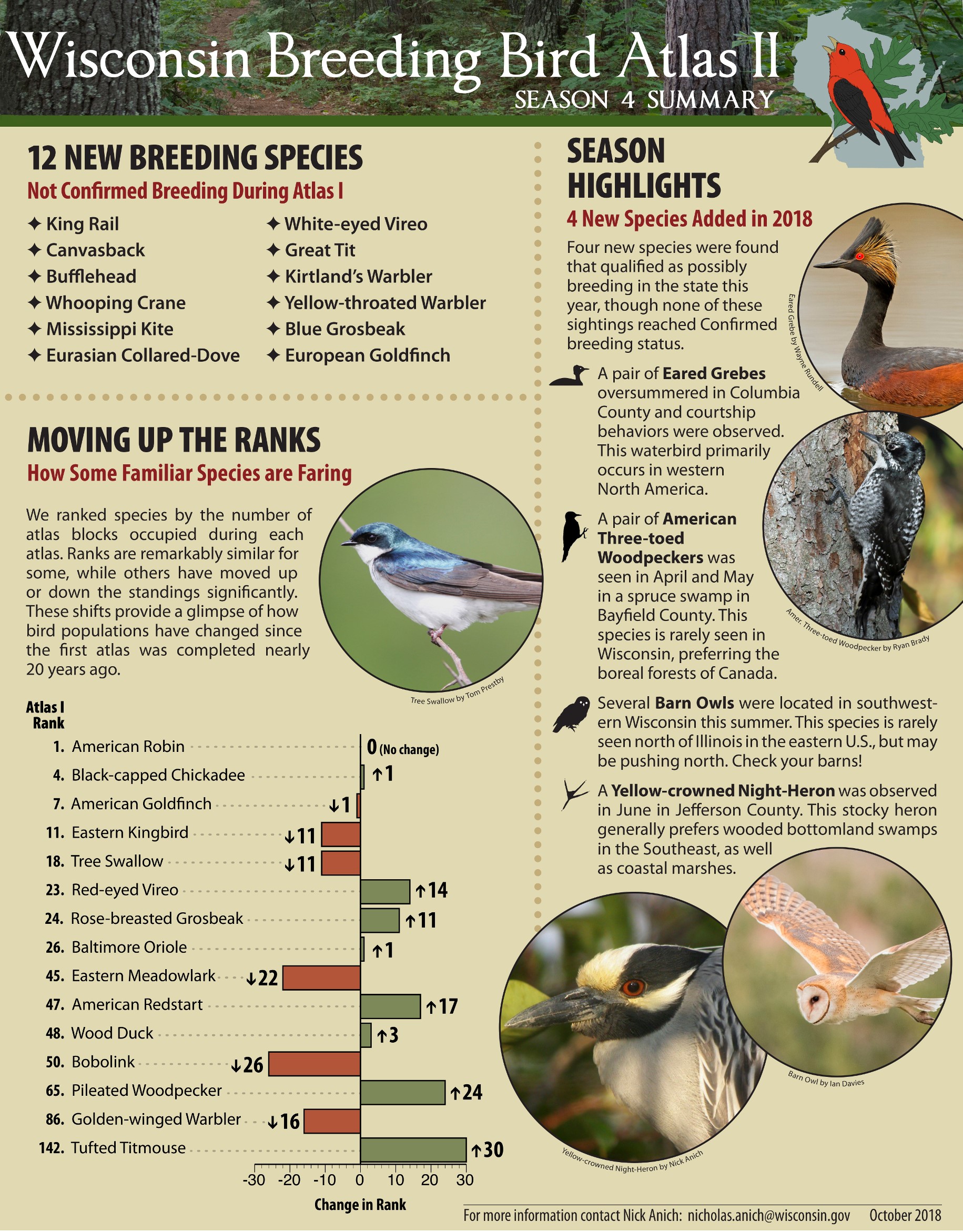After the fourth and penultimate year of the Wisconsin Breeding Bird Atlas II (WBBA II) survey, volunteers have observed 242 bird species in the state, and have confirmed 225 of those species as breeding. Of the potential breeders, four new species were found this year that could make for exciting confirmations in 2019, including Barn Owl, American Three-toed Woodpecker, Yellow-crowned Night-Heron and Eared Grebe.
“Barn Owl populations have rebounded somewhat in more favored breeding areas of Iowa and Illinois,” said Ryan Brady, Department of Natural Resources conservation biologist and science coordinator for the Atlas. “With sightings in Wisconsin slightly on the rise, it might not be long before they attempt to breed again in our southern or western grasslands.”
Yellow-crowned Night-Herons are most common in the southeastern United States, and have been confirmed breeding only a handful of times in Wisconsin since the mid-1900s. American Three-toed Woodpeckers typically breed in the boreal forests of Canada, and Eared Grebes typically breed only as far east as western Minnesota.
The 4th season confirmed one species not yet documented for the second atlas -- a Worm-eating Warbler found by Randy Hoffman in Pepin County along the Chippewa River near Five-mile Bluff Sate Natural Area. The species had been confirmed in Atlas 1.
During the first four seasons of the Atlas, 12 species have been confirmed breeding in Wisconsin that were not documented in the first atlas survey two decades ago, although no such new breeding species were confirmed in 2018. In WBBA I (1995–2000), 237 possibly breeding species were recorded, 226 of which were confirmed.
The purpose of the five-year atlas effort is to document every bird species that breeds in Wisconsin, and where and when their breeding occurs. Though data collection is still in progress, coordinators are beginning to get a sense of which species populations are trending upward or downward, or remain stable, in comparison with the findings of the first breeding bird atlas, whose field work was completed in 2000. Nicholas Anich, WI Breeding Bird Atlas II Coordinator for the WDNR, says it’s a mixed bag. “Preliminary data is showing some species groups like grassland and aerial insectivores on the decline, while other species, particularly those that may be benefiting from more forest cover, are on the increase,” Anich said.
The data collection portion of WBBA II is slated to wrap up in 2019 after the summer breeding season ends. Atlas coordinators estimate that 15% of survey blocks still need significant coverage, and 25% need some “clean-up” data collection before they are considered complete.
“In our final year we really need all hands on deck!” Anich said. “Our biggest remaining gaps are in northern and western Wisconsin, but there are still opportunities in every area of the state to help.” More than 1,700 volunteers have contributed to the survey so far, but more are needed to survey the remaining priority areas.
Anich says that the best way for volunteers to get involved is to reach out to their county coordinator, who can help get new atlasers ready to help when the final season begins. Contact information is available on web site of the Wisconsin Society for Ornithology at https://wsobirds.org/atlas-county-coordinators
Volunteers collect data by observing birds and then entering their sightings online, where the information is reviewed by Anich, Brady, and other ornithologists from organizations leading the project: WSO, the Western Great Lakes Bird and Bat Observatory (WGLBBO), the Wisconsin Bird Conservation Initiative, and the WDNR.
All Wisconsin residents are encouraged to participate, especially those who live or travel to priority areas like northern, central, and western Wisconsin. “It's easy to participate and you don't have to be an expert birder to help,” says Bill Mueller, WGLBBO director. “We're constantly hearing from people how rewarding atlasing is, and we welcome participants of all ability levels.”
To volunteer, visit the project website at www.wsobirds.org/atlas. Group data-collection events and field trips will take place throughout Wisconsin in 2019. When the project is completed, the data will be published in a hard-copy book and online for use by researchers, land managers, conservationists, and citizens interested in birds and their habitats.
4 Probable/Possible
As for the four new species recorded as Probable/Possible:
-- Ryan Brady found a pair of American Three-toed Woodpeckers in Bayfield County. They lingered into May but eventually vanished.
-- Eared Grebes over-summered at Goose Pond in Columbia County. A pair was observed building a copulatory platform and likely attempted a nest, but no nest or eggs were ever definitively found.
-- A Yellow-crowned Night-Heron was seen in Jefferson County in June. Although birders often see dispersed juveniles of this species heading northward in late summer, pinning down nesting birds for this atlas has proven difficult.
-- Several Barn Owls were seen in southwestern Wisconsin, leading to high hopes for confirming this species in 2019.
Yet to be Confirmed
There now is only one species that was confirmed in more than two blocks during WBBA I that has not yet been confirmed in WBBA II: White-winged Crossbill, a finch that breeds in northern conifer bogs, but primarily after irruption years. If an irruption does not occur this winter, it’s unlikely they’ll be found as breeders.
There remains a list of very rare breeders found during WBBA I that have not yet confirmed (number of WBBA I confirmed blocks in parentheses, zero means it was a possible or probable breeder in WBBA I):
Northern Pintail (2)
Yellow-crowned Night-Heron (2)
Yellow Rail (2)
Barn Owl (2)
Philadelphia Vireo (2)
Nelson’s Sparrow (2)
Lesser Scaup (1)
Western Grebe (1)
Snowy Egret (1)
Great Black-backed Gull (1)
Great Gray Owl (1)
Western Kingbird (1)
Rusty Blackbird (1)
Eared Grebe (0)
Tennessee Warbler (0)
Bay-breasted Warbler (0)
Wilson’s Warbler (0)
--This is one of several timely articles in this month's Badger Birder newsletter; don't miss out on the latest birding and conservation news. Become a WSO member today! https://wsobirds.org/support/become-a-member--

